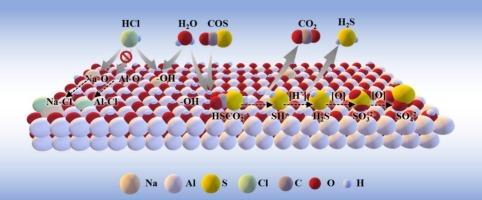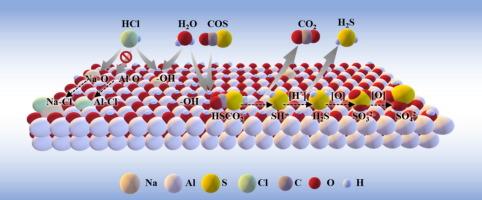Unraveling the Chlorine-Resistance and catalytic activity of alumina-based catalyst in COS hydrolysis for blast furnace gas purification
IF 9
1区 工程技术
Q1 ENGINEERING, CHEMICAL
引用次数: 0
Abstract
To improve the activity of COS hydrolysis catalysts in a complex atmosphere is a significant challenge for blast furnace gas purification. Alumina-based hydrolysis catalysts were prepared with four alkali/alkaline earth metals (Na, K, Mg and Ca) respectively by the simple impregnation method to explore the chlorine-resistance mechanism of catalysts. Among four catalysts, Na/Al2O3 and K/Al2O3 catalysts showed a higher hydrolysis conversion of COS reaching 98% for 12 h in the absence of HCl, due to the higher contents of weak basic sites as active sites for COS adsorption and more migratory oxygen species participating in COS hydrolysis. Especially, K/Al2O3 has the highest catalytic activity in that it is easy to adsorb COS and H2O due to their high absolute adsorption energy. The presence of HCl inhibits the hydrolysis of COS owing to the acidification of active components and competitive adsorption with COS and H2O. It has been further found that HCl also inhibits the migration of oxygen species and deposition of sulfur species, but HCl still has a stronger inhibitory effect on COS hydrolysis than the deposition of sulfur species. The introduction of alkali metal as sacrificial sites protects the structure of alumina-based catalysts, avoiding the combination of HCl and Al-O to generate Al-Cl. Na/Al2O3 has the best Cl-resistance mainly due to the high content of medium basic sites and great bond energy of Na-O with HCl. This research offers valuable guidance for the rational design and preparation of alumina-based catalysts with a good Cl-resistance and for the applications of blast furnace gas purification.


氧化铝基催化剂在COS水解高炉煤气净化中的耐氯性和催化活性研究
提高COS水解催化剂在复杂气氛下的活性是高炉煤气净化面临的重大挑战。采用简单浸渍法制备了4种碱/碱土金属(Na、K、Mg、Ca)的铝基水解催化剂,探讨了催化剂的耐氯机理。4种催化剂中,Na/Al2O3和K/Al2O3催化剂在没有HCl的情况下,COS的水解转化率较高,达到98 %(12 h),这是由于弱碱性位点作为COS吸附的活性位点含量较高,参与COS水解的迁移氧种类较多。其中,K/Al2O3的催化活性最高,因为其具有较高的绝对吸附能,易于吸附COS和H2O。HCl的存在抑制了COS的水解,这是由于活性组分的酸化和COS和H2O的竞争吸附。进一步发现HCl对氧的迁移和硫的沉积也有抑制作用,但HCl对COS水解的抑制作用仍强于硫的沉积。碱金属作为牺牲位的引入保护了铝基催化剂的结构,避免了HCl和Al-O结合生成Al-Cl。Na/Al2O3具有最佳的耐cl性,这主要是由于Na- o与HCl的中碱位含量高,且Na- o与HCl的键能大。该研究对合理设计和制备具有良好耐cl性能的氧化铝基催化剂以及高炉煤气净化应用具有重要的指导意义。
本文章由计算机程序翻译,如有差异,请以英文原文为准。
求助全文
约1分钟内获得全文
求助全文
来源期刊

Separation and Purification Technology
工程技术-工程:化工
CiteScore
14.00
自引率
12.80%
发文量
2347
审稿时长
43 days
期刊介绍:
Separation and Purification Technology is a premier journal committed to sharing innovative methods for separation and purification in chemical and environmental engineering, encompassing both homogeneous solutions and heterogeneous mixtures. Our scope includes the separation and/or purification of liquids, vapors, and gases, as well as carbon capture and separation techniques. However, it's important to note that methods solely intended for analytical purposes are not within the scope of the journal. Additionally, disciplines such as soil science, polymer science, and metallurgy fall outside the purview of Separation and Purification Technology. Join us in advancing the field of separation and purification methods for sustainable solutions in chemical and environmental engineering.
 求助内容:
求助内容: 应助结果提醒方式:
应助结果提醒方式:


